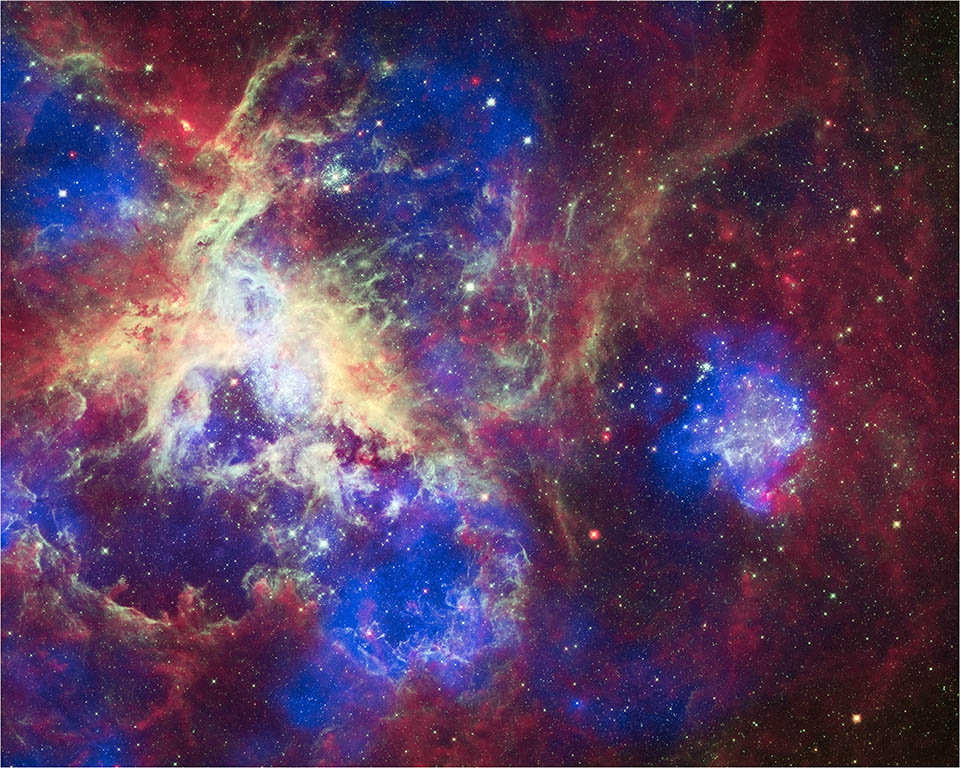







| BOOKS | F. A. Q. | ARTICLES | TALKS | ABOUT KEN | DONATE | BEYOND OUR KEN |
|---|
By Ken Croswell
Published on New Scientist (September 29, 2016)

The Tarantula Nebula in the Large Magellanic Cloud. Credit: Hubble Space Telescope. Spitzer Space Telescope. Chandra Space Telescope. X-ray: NASA/CXC/PSU/L.Townsley et al.; Optical: NASA/STScI; Infrared: NASA/JPL/PSU/L.Townsley et al.
Galaxy see, galaxy do. For the first time, the Milky Way's brightest satellite galaxy stands accused of the same type of crime as the Milky Way itself: tearing apart a celestial object that wandered too close.
The Large Magellanic Cloud is the most luminous of more than 50 galaxies orbiting our own. Lying 160,000 light-years from Earth, the galaxy is so bright you can see it with the naked eye.
Big spiral galaxies like the Milky Way are known to tear up and eat their neighbours, including some of the Large Magellanic Cloud’s brethren. But the satellite galaxies themselves have never been observed doing the same.
Now Nicolas Martin of the University of Strasbourg in France and his colleagues have spotted what looks like a globular cluster – a tightly packed group of stars – in distress. The cluster is on the outskirts of the Large Magellanic Cloud, about 42,000 light-years from the galaxy’s centre.
The team found the troubled star cluster in March as part of a search called the Survey of the MAgellanic Stellar History (SMASH), so they named the cluster SMASH 1. And it does indeed seem headed for a smash-up.
“It’s quite elongated,” says SMASH principal investigator David Nidever of the National Optical Astronomy Observatory in Tucson, Arizona. Moreover, the cluster’s long axis points right at the Large Magellanic Cloud. This suggests the galaxy’s gravity is pulling harder on the cluster’s near side than its far side, yanking it apart.
Still, if the star cluster has been orbiting the galaxy for a long time, the team says it’s strange that the destruction is occurring only now. So they suspect the cluster originally circled a less massive galaxy nearby – the Small Magellanic Cloud – with weaker gravity that didn’t tear it apart. Only recently did the Large Magellanic Cloud snatch the cluster and begin shredding it.
In 2011, astronomers reported that the large galaxy has probably purloined millions of stars from its junior partner.
SMASH 1 could even be a dwarf galaxy rather than a star cluster. In that case, it should possess dark matter with a gravitational pull that would help hold the object together and prolong its life.
But Nidever thinks the object is probably a star cluster. If so, “it will likely turn into a stream around the Large Magellanic Cloud and populate its stellar halo,” he says.
Ken Croswell earned his Ph.D. in astronomy from Harvard University and is the author of The Alchemy of the Heavens and The Lives of Stars.
"An engaging account of the continuing discovery of our Galaxy...wonderful." --Owen Gingerich, The New York Times Book Review. See all reviews of The Alchemy of the Heavens here.
"A stellar picture of what we know or guess about those distant lights."--Kirkus. See all reviews of The Lives of Stars here.
| BOOKS | F. A. Q. | ARTICLES | TALKS | ABOUT KEN | DONATE | BEYOND OUR KEN |
|---|